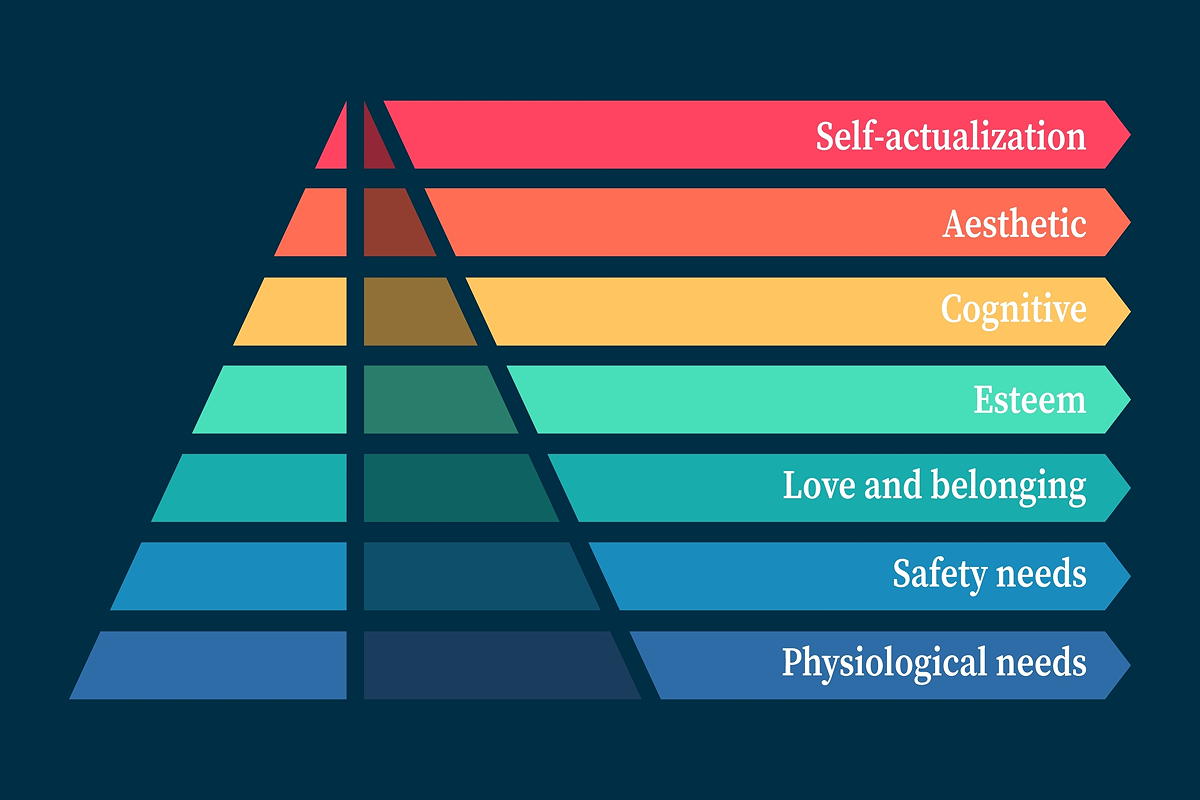Basics of Maslow’s hierarchy of needs
Did you know that Maslow’s hierarchy of needs consists of five levels that divide all deficit and growth needs? This well thought-out theory, developed by Abraham Maslow, provides a solid foundation for understanding human motivation and the development potential of each individual. From basic physiological needs to self-actualization, it provides a comprehensive picture of how people prioritize their goals and aspirations.
A central feature of Maslow’s hierarchy of needs is the assumption that all people have the same fundamental needs and motives. This “pyramid” of needs ranges from the immediately necessary basic physiological needs to self-actualization, which Maslow later expanded to include aesthetic and cognitive needs as well as transcendence.
Although the theory is widely used and has gained recognition in various disciplines, it is also criticized. One important point of criticism is the lack of empirical evidence and the simplification of complex human motivation. The hierarchy of needs, although often presented as a pyramid, does not always take into account individual differences and cultural variations.
Important findings
- 📊 Maslow’s pyramid of needs consists of five levels that show what motivates people in life 🧍♂️⬆️ .
- 🔍 Maslow distinguishes between deficit needs (such as security or food) and growth needs (such as self-actualization) 🍞🏠 🤝 💡 🌟 .
- As long as basic needs are not met, higher goals usually take a back seat.
- 💡 This hierarchy provides an important basis for better understanding human behavior and motivation – be it in everyday life, in psychology or in professional life 🧠📚 .
- 🧔♂️ Abraham Maslow later added further levels to his model, e.g. the need for self-transcendence – i.e. the striving for something that goes beyond the self 🌌✨ .
- ⚖️ Despite its importance, the theory is also viewed critically – partly because it is highly simplified and culturally westernized 🌍🤔 .
Introduction to Maslow’s hierarchy of needs
Maslow’s hierarchy of needs, also known as the pyramid of needs, is a model that categorizes human needs in order from the most urgent physiological needs to self-actualization. This model was developed by Abraham Maslow in the 1940s, originally published in his work “A Theory of Human Motivation”.
Definition and meaning
The hierarchy of needs is structured like a pyramid with five levels. The first four levels are classified as deficit needs and must be fulfilled before one can rise to higher needs. The highest level, self-actualization, is the only growth need and represents personal fulfillment. This model is a simple but practical tool for analyzing human motivation and behavior and is used in various fields such as psychology, business, education and marketing.
Origin and development
Maslow’s hierarchy of needs emerged in humanistic psychology as a response to the analytical and behavioral theory models that dominated at the time. In his studies, Maslow discovered that human needs can be arranged hierarchically and that the fulfillment of basic needs is the prerequisite for the activation of higher needs. Originally, the model only contained five levels, but was later expanded to eight levels, although this expanded version is less well known. Despite its popularity, the model has been criticized for having little empirical support and not taking sufficient account of cultural differences.
| Level | Category | Description |
|---|---|---|
| 1 | Physiological needs | Eating, drinking, sleeping |
| 2 | Security requirements | Security, stability |
| 3 | Social needs | Love, belonging |
| 4 | Ego needs | Strength, success, recognition |
| 5 | Self-realization | Exercising your own potential |
The five levels of the needs pyramid
Maslow’s hierarchy of needs consists of five levels that build on each other. Each of these levels represents different basic needs that must be fulfilled in order to move on to the next. Although they can be experienced individually, they are fundamental to human well-being and personal development.
Basic physiological needs
The first level of the pyramid of needs concerns basic physiological needs such as food, water, sleep and health. These needs are essential for human survival and well-being. Without the fulfillment of these basic needs, it becomes difficult to pursue other needs.
Security requirements
After satisfying their basic physiological needs, people strive for security. This includes protection, a stable home, financial stability and general security in daily life. A stable environment provides people with the necessary framework to feel safe.
Social needs
The third stage includes social needs such as love, belonging and community. People look for interpersonal relationships, be it with family or friends. This level of the pyramid of needs emphasizes the importance of social interaction and a sense of community.
Individual needs
The fourth level of the needs pyramid comprises the individual needs for recognition, appreciation and success. People want to feel valued and receive recognition for their achievements. This strengthens their self-esteem and motivates them to achieve further successes.
Self-realization
At the top of the needs pyramid is self-actualization. It represents the pursuit of fulfilling personal potential and goals. This state is achieved when all other needs have been met and the person continues to develop through personal growth needs.
The following table summarizes the five levels of the needs pyramid:
| Stages of the needs pyramid | Description |
|---|---|
| Basic physiological needs | Basic needs for survival such as food, water, sleep and health. |
| Security requirements | Protection, financial security, safe housing and general stability. |
| Social needs | Belonging, love, friendship and intimate relationships. |
| Individual needs | Recognition, appreciation, self-worth and success. |
| Self-realization | Fulfillment of potential, personal growth and goal setting. |
Physiological needs
Physiological needs form the most basic level of Maslow’s pyramid of needs. These needs include essential elements such as oxygen, food, water, exercise and sleep, which are directly necessary for survival. Companies can support these needs by providing healthy food and drink and ensuring the separation of work and leisure time.
Importance for survival
Physiological needs are essential for survival. They include the most basic things a person needs for life: Breathing, water, food, sleep and reproduction. These needs are also referred to as “deficit needs”, as they must be fulfilled before higher needs such as safety needs can become relevant.
Examples and applications
Physiological needs are also important in the world of work, even if they are more difficult to influence. However, employers can take some measures to support the well-being of their employees with regard to these needs. These include healthy meals in the canteen, sufficient breaks and the promotion of a healthy work-life balance.
“Maslow emphasizes that these needs are essential for survival and form the basis of the hierarchy of needs.”
Maslow’s theory of motivation clearly shows that these physiological needs must be met first. Once these needs are secured, individuals can move on to higher levels of the needs pyramid and find motivations that go beyond mere survival.
Security requirements
Security needs are a central component of Maslow’s hierarchy of needs. They include protection, stability, order as well as physical, emotional, financial and social security. These needs come to the fore as soon as basic physiological needs such as food and sleep are met.
Protection and stability
Protection and stability play an essential role in human well-being. People prefer the known over the unknown and look for explanations for unfamiliar situations. These safety needs can be met in everyday life through various measures, such as ensuring a safe living environment or securing a stable workplace. In companies, this is achieved by creating a safe working environment and complying with safety standards.
Financial and physical security
Another essential part of security needs is financial and physical security. Financial security includes adequate remuneration and social security from the employer, while physical security is ensured through healthy workplace design and regular health checks. Only when these security needs are met can higher needs, such as social interaction or self-fulfilment, be pursued.
| Category | Examples |
|---|---|
| Physical safety | Safe living environment, healthy workplace design |
| Financial security | Appropriate remuneration, social security |
| Emotional security | Stable relationships, psychological support |
Social needs
Social needs include important aspects such as love, friendship and belonging. These needs play a crucial role in human life and influence well-being and satisfaction. People strive to build established and harmonious relationships with others in order to develop a sense of belonging.
Family and friendships
Family and friendships form the foundation of social needs. They provide emotional support and security. Regular social interactions and team-building activities in the workplace promote collaboration and strengthen bonds between colleagues.
According to a study conducted by Avantgarde Experts in 2024, 34% of employees consider the meaningfulness of their work to be one of the most important factors for their satisfaction. This underlines the importance of social and growth-oriented needs in the work environment.
Social roles and belonging
Social roles and belonging are essential elements of social needs. Companies can promote these needs of their employees by creating team events, pleasant working atmospheres and open communication. Team activities and positive relationships with colleagues are crucial for emotional well-being.
Sarah, a project manager, has found that she only feels good when she has positive relationships with her colleagues. Meeting social needs in the work environment leads to increased satisfaction and productivity.
“Love and belonging to other people are fundamental social needs that play an important role in working life.”
| Examples of social needs | At the workplace |
|---|---|
| Family, friendship and social exchange | Regular team-building measures |
| Love and belonging | Pleasant working atmosphere |
| Supportive relationships | Open communication |
Individual needs
Individual needs focus on the pursuit of personal success, recognition and appreciation of one’s own achievements. These needs promote self-esteem and express the individual’s status and position of power.

Recognition and appreciation
Recognition and appreciation play a central role in individual needs. Employees who feel valued and needed in the workplace take on their tasks with greater enthusiasm. This not only increases self-esteem, but also leads to greater job satisfaction and productivity.
Success and power
Success and power are other key aspects of individual needs. These strive for recognition by others and the achievement of personal accomplishments. According to Maslow, only around 2% of the global population reaches the level of self-actualization at which these needs are paramount. The pursuit of success and power creates incentives to further develop one’s own abilities and gain social recognition.
| Feature | Description |
|---|---|
| Recognition | Appreciation of one’s own achievements by others. |
| Success | Achieving personal and professional goals. |
| Power | Influence and decision-making ability in various areas. |
| Appreciation | The feeling of being respected and recognized by others. |
Overall, individual needs are important drivers of personal growth and professional success, which have far-reaching effects on an individual’s well-being and performance.
Self-realization
Self-actualization is the highest level in Maslow’s pyramid of needs and refers to reaching one’s maximum potential. It refers to the pursuit of a meaningful, fulfilling life through personal growth and creativity. According to Horst Opaschowski, a German futurologist, self-actualization is a “privilege for minorities”.
Personal growth
Personal growth is a central element of self-realization. It describes the continuous development of one’s own abilities and skills. In 1999, around 40% of self-employed people in Germany stated that they were able to realize themselves in their job, compared with only 20% of employees. This underlines the importance of personal goals and individual progress in professional and personal life.
Creativity and meaning
Creativity is another key aspect of self-realization. It includes activities such as sports, artistic work and hobbies that match one’s own interests and abilities. These activities not only help to realize one’s potential, but also contribute to a sense of purpose and satisfaction. Maslow emphasized that only through the prior satisfaction of the lower needs can self-actualization find its full expression.
Criticism of Maslow’s hierarchy of needs
Maslow’s hierarchy of needs has given rise to numerous discussions since its creation. One of the most common criticisms is the lack of empirical evidence. Studies such as those by Taormina and Gao (2013) and Wahba and Bridwell (1976) show that the hierarchy cannot stand up to scientific scrutiny. Maslow based his theses mainly on personal observations, which calls into question the scientific basis of the theory.
Lack of empirical evidence
Maslow was unable to provide empirical data that clearly supports his hierarchy. For example, the correlation study shows that the relationship between different levels of needs is weak, for example only 23% between physiological needs and safety needs. This lack of empirical support casts considerable doubt on the validity of Maslow’s hierarchy of needs.
Cultural differences
Another key point of criticism concerns cultural differences. The theory assumes a universal hierarchy of needs, but this is not always true in different cultural contexts. For example, in non-Western cultures, belonging may often be more important than self-actualization. In practice, this assumption leads to misapplications and misunderstandings.
In conclusion, it can be said that despite its numerous criticisms, Maslow’s hierarchy of needs is still widely used. This shows that the theory, although outdated and empirically problematic, continues to play an important role in practice.
Application in the world of work
Maslow’s hierarchy of needs offers valuable insights into promoting employee motivation and effective stress management in the workplace. Companies that integrate this theory into their strategies can positively influence the working environment and significantly increase the well-being of their employees.
Motivation of employees
Employee motivation starts with basic needs. Physiological needs include ensuring that employees have enough income to cover basic needs such as housing, food and water. Safety needs relate to job security and protection from physical and financial risks, such as health insurance and a safe place to work. Social needs require a sense of belonging and connection, which can be achieved through team cohesion and mutual support. Recognition and appreciation come through constructive feedback and recognition of achievements, which strengthens self-esteem. Self-realization is achieved through opportunities for personal growth, skills development and the use of one’s own talents.
Feedback mechanisms, such as the use of “I” statements, are crucial for effective communication and motivation in the work environment.
Stress management and working environment
Effective stress management is essential for a positive working environment. Employees’ biological needs should be addressed through ergonomic workplace design, sufficient breaks and access to healthy meals. Safety needs include a secure position in the company, permanent employment contracts and protection from physical hazards. Social needs can be met through a sense of belonging, positive relationships with colleagues, team activities and participation in internal communities.
It is also important to ensure psychological safety so that employees can express their ideas and concerns without fear of negative consequences. This contributes significantly to promoting a positive working atmosphere and supports the general well-being of employees.
The extension of Maslow’s hierarchy of needs
In 1970, Abraham Maslow expanded his original model of the hierarchy of needs to include two additional levels: cognitive and aesthetic needs. These extensions emphasize the pursuit of knowledge, understanding and beauty. Maslow thus went beyond mere survival and basic needs and recognized that people also have an inner drive to understand and appreciate their surroundings. The hierarchy of needs thus developed into an even more comprehensive model of human motivation.
A central element of this expansion is the additional level of transcendence. This reflects Maslow’s later transition from humanistic to transpersonal psychology and focuses on how individuals can grow beyond their own ego. This can be through spiritual experiences, the search for a higher meaning or engagement in altruism.
Additional steps
The two new levels introduced by Maslow are:
- Cognitive needs: The motivation to acquire knowledge and understand the world. These needs relate to the desire to learn new things and accept intellectual challenges.
- Aesthetic needs: The need for beauty, symmetry and artistic balance. People consciously seek harmonious and pleasant surroundings, which can promote both their mental and emotional health.
Transcendence and higher needs
The concept of transcendence represents the highest level of the extended hierarchy of needs. It describes the experiences and motivations that go beyond individual self-actualization and relate to collective well-being. Transcendent needs include:
- Spiritual experiences: Many people seek a deep connection to the universe or a higher power that gives them a sense of belonging and significance.
- Altruism: Selfless service to others can be a source of deep satisfaction and strengthen the feeling of being part of something bigger.
- Self-transcendence: This involves overcoming one’s own limitations and achieving a high level of awareness and reflection.
To summarize, Maslow’s extension of the hierarchy of needs has significantly broadened the view of human motivation. The digital era is now influencing the way social and self-actualization needs are met through platforms such as social media. In addition, cultural contextualization can alter the hierarchy, with collectivist societies emphasizing social belonging more than individualist societies.
The importance of Maslow’s hierarchy of needs today
Maslow’s original hierarchy divides needs into five categories: physiological needs, safety needs, social needs, esteem needs and self-actualization needs. Despite criticism, Maslow’s model remains very important and relevant today. Modern companies such as Google, Salesforce and Netflix use the understanding of these categories of needs to develop strategies that optimally address the needs of their employees.
Google promotes autonomy and innovation through the “20 percent rule”, while Salesforce strengthens social connectedness through charitable initiatives. Netflix relies on trust and responsibility to offer its employees a supportive environment. These examples show the current relevance of Maslow’s hierarchy of needs in the world of work. Taking needs into account leads to higher satisfaction, commitment and productivity in these companies. On the other hand, companies that neglect these needs risk burnout, high staff turnover and poor performance.
However, the needs have evolved and are now more complex. Desmet and Fokkinga, for example, have presented an extended hierarchy with 13 basic needs that take into account aspects such as autonomy, attachment and pleasure. Moreover, the importance of these needs varies according to generation and cultural context. For Generation Z, Wi-Fi and charging stations are among the basic needs, and security needs today also include data protection on social media and secure online shopping experiences. Social and esteem needs are represented by authentic relationships and personalized messages from brands, often influenced by social media influencers.
In conclusion, despite its simplicity and lack of scientific consensus, Maslow’s hierarchy of needs remains a valuable tool for understanding and addressing human needs. Its relevance in modern contexts is particularly evident in the way companies and organizations adapt their methods to best meet the needs of their employees and customers.



